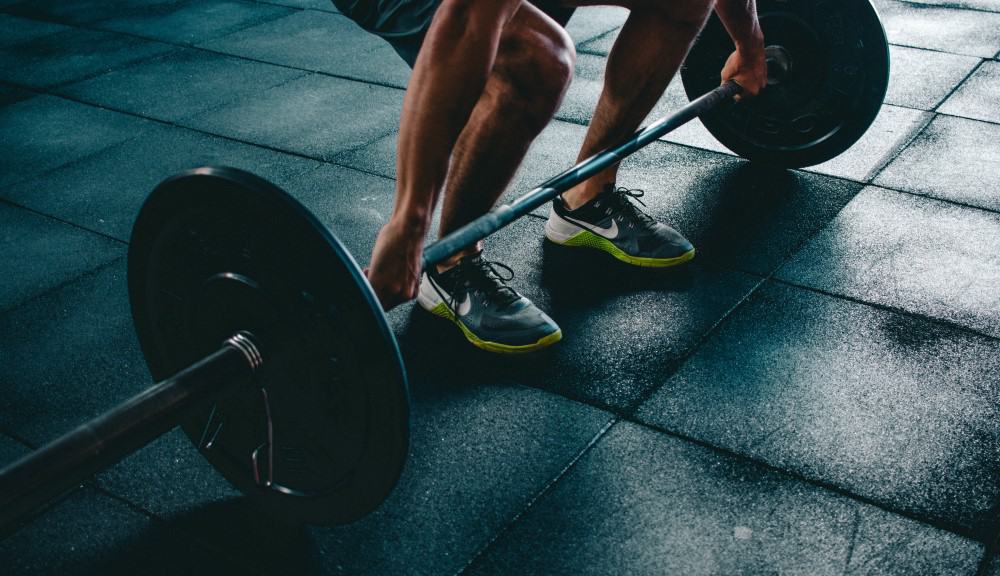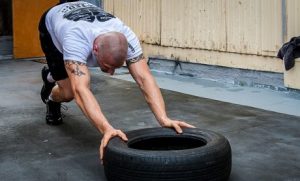Reps in reserve? Before we dive deeper into the topic, let’s take a step back.
Most people, especially our readers, know that in order to grow muscle, we need progressive overload.
It?s as simple as that. Meaning, you need to consistently increase the amount of weight you move to grow muscle.
At this point, you will ask yourself:
How do I correctly measure the amount of weight I moved?

Because, what?s better for muscle growth, doing 8 reps with 100KG, or 4 Reps with 120KG?
Also, if you do 4 sets of 8 reps, the first two sets are pretty easy but the last two are hard. Wouldn?t it be better to do 2 sets of 10 reps followed by 2 sets of 7 reps?
The answer is the principle of Auto ? Regulation.
People use autoregulation for ages for all kinds of things. Nutrition, sleeping and also training. Simply put, you let your body tell you how exerting a set was. No maths involved.
There are two common ways of auto-regulation in weight training, the RPE Scale and the Reps in Reserve Scale.
RPE = Rate of perceived exertion
RIR = Reps in Reserve
Fitness veterans will know these two, but if you don?t, no need to worry, we will cover both in this article.
Reps in reserve are a rather new trend, that developed out of the RPE scale.
What are Reps in Reserve (RIR)?
Before I will teach you how to apply the reps in reserve system, we need to clarify what reps in reserve actually are and what the difference is the RPE.
Both, RPE and RIR, are a form of autoregulation, meaning, you let your body tell you when the set is finished. According to the good old saying “You gotta listen to your body bro, it’s all about the mind-muscle connection.”.
Basically, autoregulation is a form of training and nutritional adjustment based on many different factors. The most common form of autoregulation is found in the field of strength training as the “rate of perceived exertion”, in short: RPE.
As already mentioned, based on the RPE scale, the reps in reserve system was developed. But let’s take a look at both of them.
RPE – the rate of perceived effort
RPE stands for rate of perceived effort. Generally speaking, there are different ways to express your RPE but ultimately it is a numerical measure of how hard a set was perceived.
It is important to mention, that the RPE scale was not indented for strength training at first. The actual RPE concept was founded by Gunnar Borg and was intended for runners.
The Borg scale ranges from 6 to 20. Weird range, right?
The reason Gunnar Borg chose for this scale, was that when multiplying the number by 10, you get an estimate of your heart rate.
But heart rate, etc. are no useful measures for strength training. Consequently, the Borg scale has significant drawbacks for strength athletes:
- The scale is too large. Most athletes will have a hard time estimating their RPE. Is it a 13 or a 14? Or even a 15?
- A heart rate cannot be calculated without individual adjustments. Two people will most likely have a completely different heartbeat.
- Perceived effort is hard to apply the strength training, especially with a range from 6 to 20, as most sets have fewer reps, sometimes even below 6.
Eventually, this led to the development of the RPE scale, which goes from 1 to 10.
Based on Borg, Mike Tuscherer developed this version of the RPE scale, which coaches used to rate the intensity level of training and competition among athletes. Mike’s version suits strength athletes way better, the range is more clear (1 – 10), and there is no connection to the heartbeat.
Applying the RPE scale is simple, it goes from 1 to 10. If you aim at an 8, you should end the set with 2 more reps in the tank. If you aim at 7, you should have three in the tank, etc.
You got the idea, right?
So next to the good old RPE scale, there are reps in reserve.

RIR – reps in reserve
Basically, reps in reserve are the same as the RPE system – just the other way around. Strictly speaking, both concepts are more or less the same. In my opinion, Reps in reserve are simply a more convenient way to apply the RPE scale.
The RPE scale isn’t complicated per se, but in practice, it is harder than you’d think. Yes I know – with a scale of 1 – 10 (with a 10 being maximum), it does not seem particularly complicated at first, but trust me when I tell you. Reps in reserve is a lot more simple for beginners.
Reps in Reserve, are a measure to naturally express how hard a set felt and how many sets you could have done more.
For strength and physique athletes, a rep in reserve scale from 1 to 5 is recommended. Research actually shows, that reps in reserve are a fairly accurate way to track your intensity.
0 reps in reserve mean nothing different than an RPE of 10. Wait, what?
Well, an RPE of 10 implies that you couldn’t have done a single additional repetition. The same applies to an RIR (reps in reserve) of 0. You couldn’t have done a single additional repetition.
Therefore, as already mentioned, both measure the same thing. But Reps in reserve seems to be a more simple, convenient way to tracking intensity.
Most people using the RPE scale, aim at an RPE of 5 or higher to stimulate muscle and strength gains. The same applies to RIR, just the other way around. Athletes should aim at an RIR of 5 or lower to ensure sets are hard enough to stimulate muscle growth.
Therefore, the RPE includes the RIR and vice versa.
Why should you use Reps in Reserve?
Sometimes, you hit the gym and you feel almost invincible like you could lift half the gym and simply triple your weight. But some days, you feel like skipping the whole workout and going straight to the sauna.
What do I want to say with that? Well, your body fluctuates. Because days are different. Some days you get too little sleep, food, you are stressed, you name it.
However, this also means that your estimated 1 RM value fluctuates in each session.
So it could be, that one day, you can easily do 8 reps with 80% 1 RM. The next day you didn’t get as much sleep and food, and you’ll only be able to do 7 reps. And that’s where the Reps in the Reserve system provides a ways better solution for you.
This does not mean that a system based on percentages is completely useless. It certainly is not, but it has its limitations in accuracy. Because it is a set number that does not adjust to your body’s condition.
And this is why autoregulation like reps in reserve is so important. When you aim at 2 reps left in the tank you simply do a set of 8 on a day you feel great, and a set of 6 or 7 when you feel a bit off.
The most important is that you constantly apply the principle of progressive overload. Increase weights or reps in reserve from week to week and you will see great progress.
An example could be starting in week one with reps in reserve 5 and progressing over 5 weeks to reps in reserve 0 and then you take a deload. It’s that simple.
Don’t let set numbers dictate your workout. this will not only stall progress but also higher the chance of you actually hurting yourself in the gym. I often see people forcing themselves to get back to their PR from the last workout. Don’t be that guy.
How to use Reps in Reserve
Well, we discussed that the RPE scale might not be the best way for you to measure your intensity as a strength and physique athlete. Let’s focus first on RIR and how you can start incorporating autoregulation into your training and which training forms a good for reps in reserve.
Reps in Reserve can truly be integrated into any type of workout, whether you’re looking for hypertrophy, strength, power, stamina, and more. For all of these types, if you want to get the RPE / RIR right, then I recommend that you move within the range of 5 to 0 RIR. This ensures sets a hard enough and everything above an RIR of 5 is hard to estimate anyway.
If your goal is muscle and strength, you generally want to be in the lower RIR range (e.g., 0 – 3) for most of your workout. It depends on your current exercise program and the phase of your current exercise plan. I would recommend the following guidelines:
Step 1: Start with a training program that uses percentage values, or continue your training routine as usual, and try to make an assessment of the RIR after each set, to become familiar with your bodies reps in reserve.
Step 2: Plan a new mesocycle and decide on the weight you want to use.
Step 3: Decide on the Reps in Reserve you want to start with. I’d recommend around 3 – 5 for the first weeks.
Step 4: Calculate the weight accordingly. (don’t go too high in the first week, you can make adjustments later)
Step 5: Start your week 1 and increase weights from week to week while staying within the same reps in reserve range. Throughout the mesocycle, you can lower your reps in reserve to increase intensity. In week 3 you can lower to 2 RIR.
When you learn to judge the Reps in Reserve (in relation to a certain percentage of your estimated 1 RM value), you can get started and adjust the scale to your needs.
But keep in mind, studies show that going to failure will limit your progress.
The sweet spot is maintaining proper intensity while not going to failure too often. This will not only prevent you from getting hurt, but it will also boost your progress and well-being.
However, it is best practice to have an AMREP (as many reps as possible) set at the end of your cycles to identify your RIR 0.
Doing this from time to time is crucial to ensure you are counting the reps in reserve correctly. Besides, AMREP is super fun and will give you a precise measure of your 0 RIR.
Because, like most people, you will find that you were either closer to failure all the time, or you could have done more reps than expected.
What are the disadvantages of Reps in Reserve?
There are definitely disadvantages, but the good thing is that you can work on them.
The better your lifting skills are, longer you go to the gym, and of course the longer you use the reps in reserve system, the better you will be in assessing RIR during an exercise or a workout. But there are some things you need to take care of.
Your Mindset
Some lifter (me included) love to go balls to the wall. that often happens when working out with a new gym buddy. You squeeze out the last rep but note down a rep in reserve of 2. So if you are like me and you tend to overestimate yourself, stop it. You don’t need to show off and you want to progress.
However, there the opposite also exists. Some people overthink the whole RPE and RIR thing. They spend hours at home calculating sets and reps but end up under assessing their own skills because they are scared of overtraining. Also, these people leave gains on the streets.
As always, balance is key. Be honest about your effort, but don’t overcomplicate it.
Hard to Assess
For bodybuilders and powerlifters reps in reserve are a great measure. The problem is, as soon as you want reps in reserve of higher than 5, estimation becomes difficult. Because many people (me included) will not be able to state the difference between an RIR of 6 and an RIR of 7.
If you want to go that low in intensity, don’t use Reps in reserve.
Conclusion: Reps in Reserve
As you can see, reps in reserve are not that complicated and can easily be incorporated in your workout. Even if you don’t have years of training under your belt.
However, the more advanced you are, the sooner you should use it. That does not mean that RIR is a must use for all athletes, but especially for isolation exercises reps in reserve are a great tool.
By setting limits too how close you are to failure, you move enough weight to stimulate muscle growth and strength gains, while the minimizing risk of injury.
Reps in Reserve can truly take your lifting career to the next level.
Maybe it may seem a bit hard at first, but with time comes the perfection. Trust me, you need to get used to reps in reserve at first, but after a while, you wouldn’t want to go back. It’s simple, yet effective.





4 thoughts on “Reps in Reserve – Complete Guide 2019”
How would you monitor training load with RIR? Calculate VL and then multiply by average RIR converted to RPE (i.e. if average RIR was 4 for a session then RPE would be 6 and multiply this by VL)?
I only take sets as Volume. Meaning 3 sets of bench and 3 sets of flys will count as a volume of 6 sets, no matter the reps or RPE. Does that make sense?
I blog quite often and I really thank you for your information. Your
article has truly peaked my interest. I
will take a note of your blog and keep checking for new information about once
a week. I subscribed to your RSS feed too.
Thanks a lot!